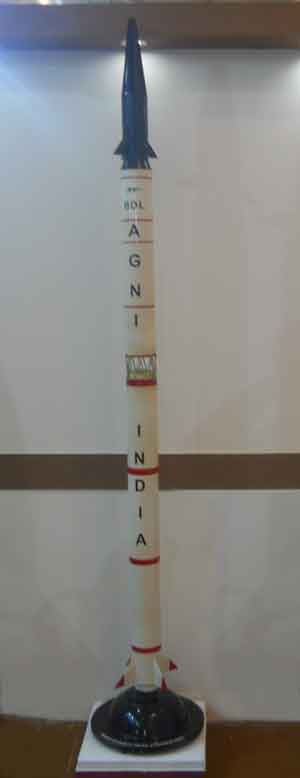 It was a red letter day for the DRDO when the Agni V ICBM was successfully test fired on 19 Apr 2012. Indeed, it was a landmark event for the country as far as its military security is concerned. The nation rightly was rapturous at this achievement and the Defence Ministry and the DRDO had reason to be proud. A statement made by some Chinese analysts, stating that the actual range of the missile was 8000 km and not just 5000 km as announced by the DRDO, added coyness to the happiness all around. “How modest of us?” many wondered.
It was a red letter day for the DRDO when the Agni V ICBM was successfully test fired on 19 Apr 2012. Indeed, it was a landmark event for the country as far as its military security is concerned. The nation rightly was rapturous at this achievement and the Defence Ministry and the DRDO had reason to be proud. A statement made by some Chinese analysts, stating that the actual range of the missile was 8000 km and not just 5000 km as announced by the DRDO, added coyness to the happiness all around. “How modest of us?” many wondered.
However, statements made by some ‘experts’ that the missile would act as a deterrent to aggression is perhaps misplaced.
Great strides made in missile technology and development has been one of the rare success stories of defence research, development and production in India. One has to feel proud of this achievement of the DRDO. But how should the students of defence strategy view this capability in the overall context of India’s defence preparedness and her ability to impose credible military deterrence over those adversaries who might attempt to secure their political objectives through military means?
The answer lies in examining as to what paradigm shift has this missile made in India’s favour.
Political direction to this effect must be given and progress monitored to ensure bureaucratic red tape is removed and the modernisation process is expedited.
Will the Agni V – and its earlier versions – subdue China’s outlandish territorial claims, or giving up the Shaksgam Valley which she received from her ‘all weather friend’, or stop her from making in-roads into Pakistan Occupied Kashmir, or from propping up Pakistan to keep India down? Will a fear of this missile deter her should she decide to seal her claims by military aggression? The answer is in the negative. In fact, nothing short of a balanced and modernised conventional military force would achieve that aim. To that end, it is essential that the drive to modernise the Indian armed forces within affordable budgetary provisions, must not be allowed to flounder. Political direction to this effect must be given and progress monitored to ensure bureaucratic red tape is removed and the modernisation process is expedited.
Will the missile at the least strengthen India’s ability to resist a military offensive, say by threatening to, or by actually destroying value targets, civilian or military, deep inside the Chinese mainland, while our armed forces are locked in intense, but perhaps unequal, combat? Will five, ten or twenty attacks with such missiles break the Chinese people’s will to fight? The answer is again in the negative; while most analysts are aware of this, only the soldiers, sea-warriors and air-warriors acknowledge it. A regime that condones mass killing and destruction of entire societies to build ‘great’ dams or to ‘revolutionise culture’ just to keep the ‘great helmsman’ and his ‘party’ in absolute power, is unlikely to be too concerned about the possible damage that Indian missiles can inflict. In any event, Chinese capability in this field far exceeds India’s.
Though Indian missile capability can act as a deterrent against Chinese missiles, it is no substitute for conventional capability required to defend our land borders. While China is unlikely as of now to use force to press her claims along the McMahon Line and in parts of Ladakh, the deterrent required by India has to be based on conventional capability. This would require capability in the cyber domain, network centric warfare capability, air dominance over the Tibetan Plateau, improved artillery support, enhanced infantry capability and an improved logistic infrastructure. All of these are planned for as per the Army’s modernisation plan. It must now be ensured that slippages in the process do not occur. It would be a mistake to simply rely on missiles for our defence.
For the missiles to make their mark, therefore, India has to have a strong conventional military capability.
While the successful launch of the missile is a credible achievement, it cannot be a substitute for lack of capability in the conventional domain. The focus thus must not shift from the modernisation process in the vague hope that missiles can be appropriate instruments of deterrence. Military security of a nation is a multi-tiered structure, with each tier complementing the others to construct a strategic whole. Missiles of nuclear and conventional payloads and of varying ranges are at the top of that multi-tiered structure which must be supported by stronger structures from beneath – one cannot have a wonderful top floor when lower floors are tottering. For the missiles to make their mark, therefore, India has to have a strong conventional military capability.
The successful development of the missile is certainly a feather in the cap of the DRDO. However, this success needs to be replicated in other projects too if India’s military is to become a force to be reckoned with.
While the nation rightly celebrates the successes achieved in missile development, serious students of national security, civilian or military must certainly pause before doing so. They must continue to work for a comprehensive security architecture and workable deterrence that allows India to prosper in peace.




